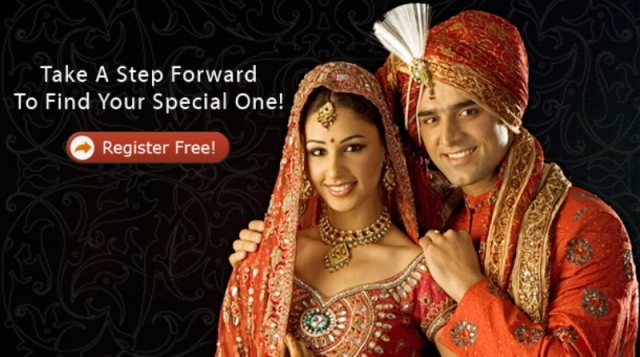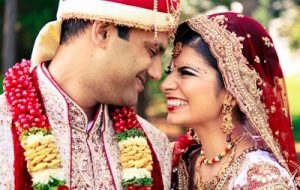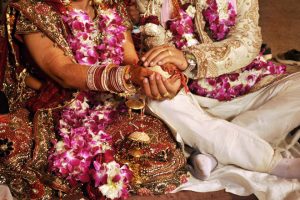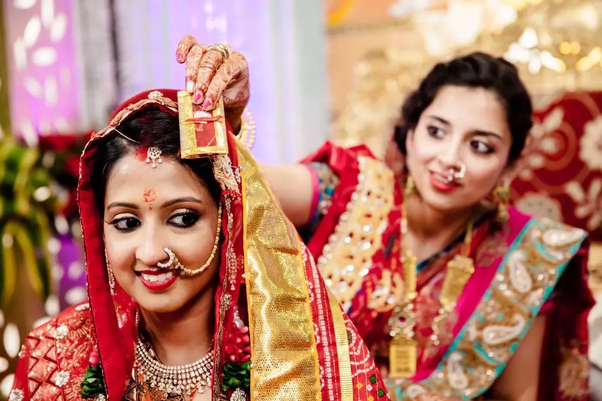
Marwari Matrimony, rituals & culture
Marwaris are coming from the modern day Jodpur region of the Marwar region, in West South Rajasthan, India. In modern times, Marwar is one of India’s largest commercial communities. Rich and prosperous, expensive wedding ceremonies are expensive in the Marwaris’ wedding days. Yet it comes in customs and rituals when Marwari marriage is very traditional. They are wide and superb to show the resources at a wedding where unmistakable but an understated yet done way of rituals. To learn more about customs involving Marwari Wedding, read.
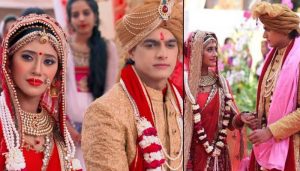
Pre Wedding Rituals for Marwari Weddings
Sagai – Sagai mentions the ceremony to join the traditions of Marwari. The event takes place in the groom’s house. On behalf of bride, male members meet the groom’s family and the Prophet’s brother has ordered to take the match on the forehead of the bride by applying the vaccine and rice vaccine. Women generally do not take part in Sagai ceremony. It is known as Mudha-Tikka ceremony.
Mass Population – A couple of days before the marriage, both the bride and groom family celebrated the ceremony where they established wedding ceremonies by installing Lord Ganesha idol on the holy church in a process known as the Constituent Assembly.
Green Peace – Puja is performed in the house of Puja or both the families of Hawaan or priests. During the end of the marriage, it is clear that they are big and the asteroid encourages the Lord. Dinner is prepared for the fire so that she can pray.
Pithi Dastura – Pithi Dastu refers to an event like Haldi in other cultures. Yellow, sandalwood and sometimes beans are applied to a bride and groom referred to as a paste paste. The bride wears traditional yellow or orange clothes and sits under a colorful channel where her family members with her mother apply paste on her hands, feet and face. Then he was provided water by women from the body of water. As well as traditional wedding songs, women continued singing. The whole atmosphere is passionate and gay. The same customs are followed in place of the groom. The bride or groom is not allowed to leave home after the pitha dastura, till the wedding day.
Mehfil – It refers to the festivities in the evening seen in the days before the wedding. Men and women get together separately and enjoy themselves by performing songs and dance routines. The bride Mehfil was officially encouraged and placed in a special seat. All the celebrations are aimed at making his smile. The groom is the only male who can celebrate women. Similarly, men have their own celebration arrangements where women are not strictly allowed.
Mahi Dastur – During this ceremony, the mother and mother of both the bride and groom go to their homes and bring gifts. Gifts are to wear the bride and groom clothes that are worn for wedding, jewelry, fruit and sweet time for the whole family. The bride or groom’s mother welcomes her brother and her family and treats him with cooking at home. The basis of this practice comes from the belief that even after marriage, the marriage of his brother will help his sister during the family function, where the expenditure is large.
Genu – On the eve of marriage, after completing worship and haven, a sacred thread was presented to the groom by the priest. At this event an ice dress groomed bride dresses. By performing this program, he understood and accepted the responsibility of married life and started the Brahmacharya Ashram from the Ashram.
Palla Dastura – A bridegroom’s bride comes to the bride’s house with a garment, jewelry, cosmetics and accessories gifts. This includes her bridal jewelry and outfit. These articles are displayed in a public area of the household for family members and family friends.
Wedding dress in Marwari Wedding
The traditional Marwari groom carries an Achan, on which he usually becomes Jodhpuri or a Sarnavani. She wears a churidar trousers with the clothing described above. She wears a turban on her head made with traditional Marwari red bamini printed fabrics. Turbans are assembled by a traditional jewelry known as Sarpak. She wears a pair of a Rajasthani jute on her feet. He made of gold, or wear a string of pearl or even a Jadau piece. He may not be stuck in the sword along with Kamarbanda where he is supposed to carry. The whole look of a Marwaris Groom royal and royal screams.
Lehnga-Cholie, a traditional dress of a Marwari bride. Typically red and similar colors are optimal. Leinigas often have heavy embroidery work with beads and gold threads. They may sometimes be embellished with stones and crystals. He adds his Lehenga choly to that which is equally heavy and absolutely unclear, because the mother of the bride covered her face throughout her marriage. She wears a ton of jewelry with her wedding dress almost adorning all body parts. Rakhi is worn on the head, diamond-studded poodle surrounded by a miniature bone, an old finger in Chudia, Bajuwand is often a surgery made of gold and stone, bed sheet and ring nose. She wears an ideal jewelry known as Borla on her forehead similar to the Mourtica. Jewelry is made of gold, but in most cases it is a wide range of Jadau, Minarakari and Kundan works, which are characteristic of Marwar region.
Nikki – The groom will take the head for the wedding ceremony, an extensive ceremony involving headgear known as Sehara is practiced. Sehara is tied around the head of the groom and is made of flowers or jaris or sometimes pearl strings. This covers the mouth of the groom. Sehrah is traditionally tied by the groom’s husband, her sister’s husband. The brother’s wife applied her mother-in-law, then her eyes to stop the evil power beside the face of the temple. He closed the golden thread on the reins of the mare that is supposed to be mounted on the groom.
Barat – Bert, referring to the wedding procession with Varendra for the wedding procession, referring to the wedding procession. He must be riding on a dirt and carrying a sword, this is a traditional reminder of royal and military heritage. Only men join the groom with the groom.
Toran – The wedding venue is widely equipped with entrance to the entrance. The groom is supposed to hit it with a stick from the neem tree while on his way. This negative power helps the ward off.
Barat Dhukve and Arri – The groom meets with the host party at the entrance. The bride’s mother performs a wide variety of sweet and feeding her with water. The groom is then welcomed inside the venue.
Jaymala – Nabadu was brought to Mandap’s marriage. He kept seven swords on the groom’s head. Suhali is a kind of addiction. This follow bride and groom garlands exchange.
Granty Ties – The bride and bridegroom are connected by connecting a knot between them. Identifies the union of these two souls.
Kadidanan – During the ceremony, bridegroom was handed over to her father. The father of the bride is sincerely asked whether she is willing to take responsibility for referring her daughter’s whole genome. The same style was repeated with the bride, who took the groom’s family and her title. Couple to go through the challenges of life together and gesture promises to support all their lives.
Pawnman – After the promise, the bride keeps her hand on the upper part of the bride’s groom. The groom receives the Prophet’s hand from his father and the Panigrahan ceremony is completed by tying up a sacred thread with a united hand.
After the sheep – after the purchase, the couple took away. Here, the bride and groom visit the Holy Fire almost seven times. For the first three Phreas, before the bride groom, and during the last four years he followed the groom around the fire. They make seven sacred pledges during the marriage of Perera and their intention to keep this seal together for the rest of their lives.
Ashrafohon – The bride kept the ants stone on her legs. He must push the stone with his feet seven times. This event represents the challenges faced by the Prophet during his marriage, and he realizes that he will face them with firm conviction and determination.
Vhamang Steepana – The bride’s brother gives rice to his mobile phone, which is why the groom and groom have to enter the holy fire together. After this event is over, the couple expresses her identity in her husband’s family with the bride sitting on the left side of the groom.
Satpadi – The bride and groom then took seven steps together that started their husband and wife’s journey.
Sare-Guti or Sindhu Dan – A dish containing rice, mung dal, jigari, cash and sweet is given to bride bride. The bride’s sister opens the bride’s hair separator and applies the vermillion to the bride’s hair parting. A nath or nose ring is then brought by the groom’s mother and placed on the bride’s fold. Nath’s clothing is expected to be worn by the bride at the end of the hand.
Anjhala Bharai – A bag of money was withdrawn from the bridegroom’s bag by her father-in-law, and was welcomed to the Mauryan sky in the Jodhpur region of Moradhar, India’s western southern Rajasthan. In modern times, Marwar is one of India’s largest commercial communities. Rich and prosperous, expensive wedding ceremonies are expensive in the Marwaris’ wedding days. Yet it comes in customs and rituals when Marwari marriage is very traditional. They are wide and superb to show the resources at a wedding where unmistakable but an understated yet done way of rituals. To learn more about customs involving Marwari matrimony.
How 99marriageguru works for Marwari matrimony?
99marriageguru.com is provide leading online matrimony service for marwari community. Other than matrimony service 99marriageguru also provide Assisted matrimony, NRI matrimony, Elite matrimony service for Marwari community.
99marriageguru also provide Event management Service, Pre marriage investigation service for Marwari community.
